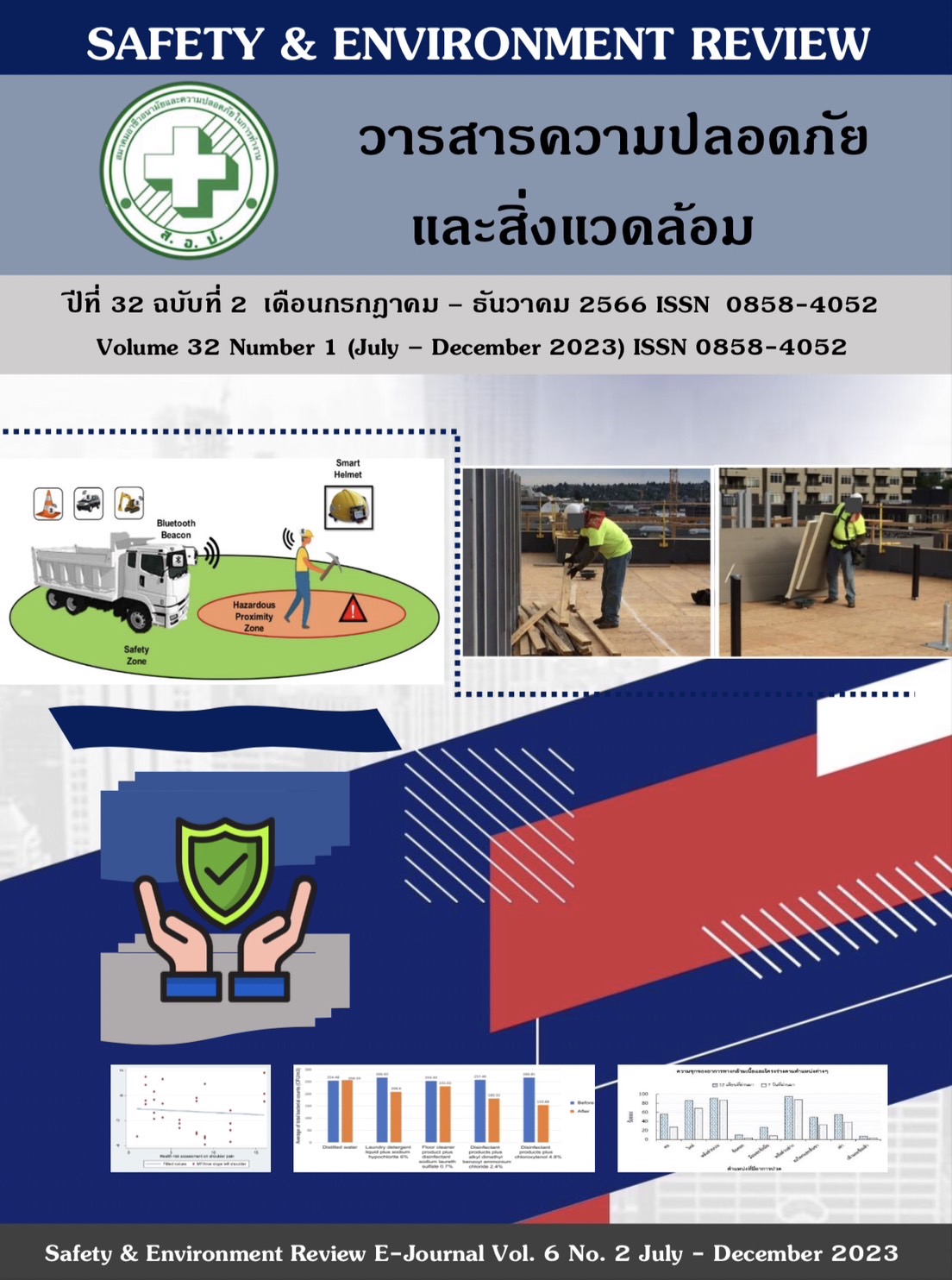A REVIEW STUDY OF INNOVATIVE WEARABLE TECHNOLOGY IN SAFETY, EFFICIENCY, HEALTH FOR WORKERS
Keywords:
Wearable devices, Fatigue tracking device, Safety, Productivity, WorkerAbstract
This article is an academic article to study and explain the meaning of wearable technology innovation. For workers who may have an incident that causes danger, is unsafe, or provides public services. Including presenting useful features and introducing innovative wearable technology. For workers to develop work for work in industries where work poses a risk to safety for workers and service recipients. This helps in developing tools or technology tools that can be used for maximum utility in work. In this academic article, the researcher has classified innovations in wearable technology. According to the benefits of wearable devices, there are 3 types: safety, and performance. and health of workers which from the results of the study, the study of the study researcher summarizes the benefits and uses of each type of wearable device as a guideline for setting strategies and goals for safety management in organizations as well as security policies related to operators. Work to have good work efficiency and affects personnel management in effectively setting policies or health care plans for workers.
References
Collier R, Randolph AB. Wearable Technologies for Healthcare Innovation. SAIS 2015 Proceedings. 2015;18(Wearable Technologies for Healthcare Innovation):1–6.
Huhn S, Axt M, Gunga HC, Maggioni M, Munga S, Obor D, et al. The Impact of Wearable Technologies in Health Research: Scoping Review. JMIR mhealth and uhealth. 2022 Jan 25;10.
Khakurel J, Porras J, Melkas H. Tapping into the Wearable Device Revolution in the Work Environment: A systematic review. Information Technology & People. 2018 May 14;31.
Hwang S, Lee S. Wristband-type wearable health devices to measure construction workers’ physical demands. Automation in Construction. 2017 Jun 1;83.
Mudiyanselage S, Nguyen P, Rajabi MS, Akhavian R. Automated Workers’ Ergonomic Risk Assessment in Manual Material Handling Using sEMG Wearable Sensors and Machine Learning. Electronics. 2021 Oct 19;10:2558.
Jebelli H. Wearable Biosensors to Understand Construction Workers’ Mental and Physical Stress. 2019 The University of Michigan Library. 1-306 p.
Chan C, Hao P, Gygax A, Nirmalathas A. Wireless Charging of Smartwear for Health and Safety Monitoring System. 2020 IEEE PELS Workshop on Emerging Technologies: Wireless Power Transfer (WoW), Seoul, Korea (South), 2020, 223-227 p.
Greenfield R, Busink E, Wong C, Riboli-Sasco E, Greenfield G, Majeed A, et al. Truck drivers’ perceptions on wearable devices and health promotion: A qualitative study. BMC Public Health. 2016 Jul 30;16 p.
Patel V, Chesmore A, Legner C, Pandey S. Trends in Workplace Wearable Technologies and Connected-Worker Solutions for Next-Generation Occupational Safety, Health, and Productivity. Advanced Intelligent Systems 4 (2021): 1-30 p.
Okhifun G. Wearable Technology: Its Place in Workplace Wellness [Internet]. Corporate Wellness Magazine 2020; 2020. [Internet]. [cited 2023 Mar 30]. Available from: https://www.corporatewellnessmagazine.com/article/wearable-technology-its-place-in-the-workplace
Kaul A. Enterprise Wearable Technology Case Studies [Internet]. Enterprise Wearable Technology Summit East; 2016. [Internet]. [cited 2023 Mar 30]. Available from: https://artillry.co/wp-content/uploads/2020/03/Enterprise-Wearable-Case-studies-II.pdf
Sarkar S, Ghosh A and Ghosh S. S. Study of Cardiorespiratory and Sweat Monitoring Wearable Architecture for Coal Mine Workers. 2020 IEEE REGION 10 CONFERENCE (TENCON), Osaka, Japan, 2020, 355-360 p.
Grand View Research. GVR Report cover U.S. Healthcare Personal Protective Equipment Market Size, Share & Trends Analysis Report By Product (Hand Protection, Respiratory Protection), By End Use (Hospitals, Home Healthcare), And Segment Forecasts, 2020 - 2027 [Internet]. [cited 2023 May 6]. Report No.: GVR-4-68038-957-9. Available from: https://www.grandviewresearch.com/industry-analysis/us-healthcare-personal-protective-equipment-market
Kim Y, Baek J, Choi Y. Smart Helmet-Based Personnel Proximity Warning System for Improving Underground Mine Safety. Applied Sciences. 2021 May 11;11:4342.
De fazio R, Al-Hinnawi AR, Vittorio M, Visconti P. An Energy-Autonomous Smart Shirt Employing Wearable Sensors for Users’ Safety and Protection in Hazardous Workplaces. Applied Sciences. 2022 Mar 13;12:2926.
Lee D, Chong T, Lee BG. Stress Events Detection of Driver by Wearable Glove System. IEEE Sensors Journal. 2016 Nov 4;PP:1–1.
Zhang X, Li J, Liu Y, Zhang Z, Wang Z, Luo D, et al. Design of a Fatigue Detection System for High-Speed Trains Based on Driver Vigilance Using a Wireless Wearable EEG. Sensors. 2017 Mar 1;17:486.
Lee W, Lin KY, Seto E, Migliaccio G. Wearable sensors for monitoring on-duty and off-duty worker physiological status and activities in construction. Automation in Construction. 2017 Jun 1;
Masci F, Spatari G, Bortolotti S, Giorgianni C, Antonangeli L, Rosecrance J, et al. Assessing the Impact of Work Activities on the Physiological Load in a Sample of Loggers in Sicily (Italy). International Journal of Environmental Research and Public Health. 2022 Jun 23;19:7695.
Chen B, Grazi L, Lanotte F, Vitiello N, Crea S. A Real-Time Lift Detection Strategy for a Hip Exoskeleton. Frontiers in Neurorobotics. 2018 Apr 1;12:17.
Hinze A, Bowen J, König J. Wearable technology for hazardous remote environments: Smart shirt and Rugged IoT network for forestry worker health. Smart Health. 2021 Dec 1;23:100225.
Downloads
Published
Issue
Section
License

This work is licensed under a Creative Commons Attribution-NonCommercial-NoDerivatives 4.0 International License.
This article is published under a Creative Commons Attribution-NonCommercial-NoDerivatives 4.0 International License (CC BY-NC-ND 4.0), which allows others to share the article with proper attribution to the authors and prohibits commercial use or modification. For any other reuse or republication, permission from the journal and the authors is required.



